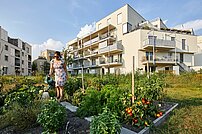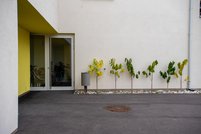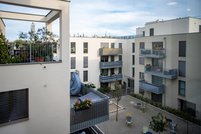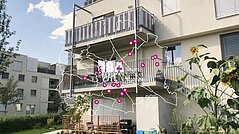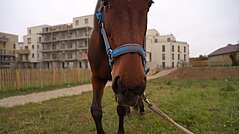MGG²²
1220 Wien
Cooperation Partners
Mia-Lassnig-Straße 32/19
1100 Wien
To route

The Game Changer in Housing Energy Supply
>> Now that the first buildings are in place and people see that it works, the decisions are becoming increasingly courageous. <<
Harald Kuster, FIN - Future is Now, Kuster Energielösungen
MGG²² - more than living.
MGG²² stands for the new residential project in Mühlgrundgasse/ Fahngasse in Vienna's 22nd district. A total of 160 housing units has been built on three plots. The special thing: Here, for the first time in social housing, thermal component activation (TCA) is being used for heating and cooling with wind energy. In addition to the energy concept, the project also impresses with its open space design. The adjoining belt of woods and meadows can be used as a large-scale community garden. The terraced gardens, balconies and loggias on each floor of the resitential building complete the attractive environment in the sense of an "edible city".
"Edible City" and neighborhood
The planting strategy of the open spaces is the "edible city." Fruit trees, herbs and berries are a constant companion when spending time in the neighborhood. Collective harvesting, for example, offers low-threshold points of contact for living neighborhoods.
The adjacent forest and meadow belt is used as a community garden on an area of approx. 2500m² and is available for use as a social and horticultural meeting place for both the residents of MGG²² and the surrounding neighborhood. After social-organizational support during the occupation phase of the housing complex, the community garden has been operated independently by the association "Stadtgemüse²²" (www.stadtgemuese22.at) since April 2020.
Sustainability, innovation and prospects for use
In the MGG22 residential quarter, thermal component activation was combined with excess wind power, brine-to-water heat pumps with deep probes, and the possibility of energy- and resource-efficient cooling. This synergistic energy system was used on a larger scale for the first time in the world. The building component activation is a proven low-tech system. What is new is that the concrete floor ceilings are used not only for heating and cooling but also at the same time as energy storage for excess wind power. The activation of the ceilings revolutionizes building cooling, which is becoming increasingly important due to the climate crisis.
read moreThe economic advantage with very low running costs (heating and cooling tempering) benefits the residents and is at the same time of social relevance.
The footprint over the life cycle of MGG22 is excellent. The residential quarter opens new perspectives on affordable and ecological energy solutions. Multiplication and further development - especially in subsidized housing, combined with photovoltaics and ecological construction methods (e.g. with wood activation) - can shape the city of the future through ecologically sustainable construction and management, keyword "Storage City," where the above-ground communicates with the underground.
The equally economical and physiologically pleasant cooling of ceilings offers the highest quality of living as well as quality of stay even on "dog days" (resilience). This strategy of climate impact adaptation should definitely be used in the many mostly disadvantaged regions of the world - as a solution approach of ambitious and overdue climate goals. This is a challenge for housing construction as well as for politics and for us as a society.
Features
- First thermal component activation in subsidized housing construction
- Year-round supply with 100% renewable energy
- Innovative open space design "Edible City"
- Professional community building in the moving-in phase
- Foundation of the association "Stadtgemüse²²" for the organization of the community garden
Facts and Figures
- 160 housing units on 3 plots of land: thereof 108 privately financed rental apartments, 20 subsidized SMART apartments, 32 subsidized rental apartments
Completion
August/ September 2019
Videos
Related Events
MGG²²: Führung durch das Projekt*

MGG²² ist das Wohnhausprojekt in der Mühlgrundgasse/Fahngasse. Die Initiator*innen und Planer*innen geben bei einer Führung einen Einblick in das fertiggestellte Projekt.
Cooperation Partners
Mia-Lassnig-Straße 32/19
1100 Wien



